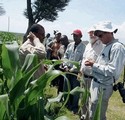 ACIAR’s Dr. John Dixon and Dr. Daniel Rodriguez of the Queensland Alliance for Agriculture and Food Innovation, with farmers from Melkassa, Ethiopia ACIAR’s Dr. John Dixon and Dr. Daniel Rodriguez of the Queensland Alliance for Agriculture and Food Innovation, with farmers from Melkassa, Ethiopia |
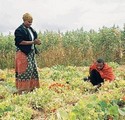 A maize – legume farm in Tanzania A maize – legume farm in Tanzania |
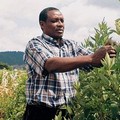 Government extension officer Frank Swai, Tanzania Government extension officer Frank Swai, Tanzania |
 Farmer and single mother of four Felista Mateo, Tanzania Farmer and single mother of four Felista Mateo, Tanzania |
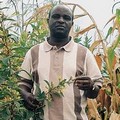 CIMMYT’s Dr. Fred Kanampiu, Tanzania CIMMYT’s Dr. Fred Kanampiu, Tanzania |
By Judie-Lynn Rabar and
Dr. Gio Braidotti
East African farmers are spearheading a research drive to intensify crop production of their most important staple foods. The farmers’ experiments with conservation agriculture and variety selection are part of a broader, 5-country push to stave off a looming food and soil-health crisis.
Kilima Tembo is a secondary school in the Karatu district in Tanzania’s rural highlands. Here, near the Ngorongoro Crater and Tarangira National Park, agriculture is king and food security rests squarely on grains grown in the region’s maize–legume intercropping system.
So important is farming to the community that the school has an agriculture teacher and the school head, Ms Odilia Basso, has allowed the Selian Agricultural Research Institute (SARI) to use school grounds to run field trials as part of a 5-country initiative to overhaul the maize and legumes supply chain—from farm to market.
That means breaking with a long-standing cycle of lifting production simply by bringing more land under the plough. The ecological consequences of that approach are catching up with farmers and their environment, but agricultural science is providing more sustainable alternatives to improve food security.
The research-based strategy is called SIMLESA—sustainable intensification of maize–legume cropping systems for food security in eastern and southern Africa. Launched in March 2010, the project is supported by the Australian Government through ACIAR.
Ambitious aims
A major objective is to introduce conservation agriculture techniques and more resilient varieties to increase the productivity and resilience of this vital cropping system. SIMLESA is aiming not only to increase yields by 30% from the 2009 average but also to reduce, by the same factor, risk from yield variability between seasons.
The Kilima Tembo Secondary School will help achieve these goals. The school is hosting the so-called ‘Mother Trial’—a long-term SARI field trial of conservation agriculture. This farming practice involves conserving ground cover between harvests to preserve soil moisture and, over a number of years, radically improve soil health and fertility.
Unlike 11 other farmer-led field sites established by SARI (the so-called ‘Baby Trials’), the Mother Trial is managed directly by the institute’s scientists, landing the school’s students with front-row seats on research and development activities designed to sustain a farming revolution.
Mr. Bashir Makoko, an agronomist working on the SIMLESA project, says students have the opportunity to learn about the project and its significance to the community at an open day with scientists and extension workers from SARI.
The socioeconomist running the trial, Mr. Frank Mbando, is encouraging student participation. He has arranged for data to be collected in ways that allow students to interact with technical staff. “Direct involvement in the project will equip the students with the information they need as potential farmers,” he says.
Household and regional impacts
Supporting these activities are partnerships that link farmers with a suite of national resources—extension officers, research centres and agricultural ministries—and international research centres.
Coordinating these linkages is Dr. Mulugetta Mekuria, from the South African regional office of the International Maize and Wheat Improvement Center (CIMMYT). Also involved is the International Crops Research Institute for the Semi-Arid Tropics (ICRISAT).
Dr. Mekuria says SIMLESA was designed to have impacts at both the household and regional level.
“The aim is to ensure food security through agricultural research, stronger economic institutions, partnerships, and capacity building,” he says. “We want to increase food security and incomes while driving economic development through improved productivity from more resilient and sustainable maize-based farming systems.”
To implement the program, Dr. Mekuria is using the ‘3-I Approach’, a research for development (R4D) strategy designed to enhance smallholder prosperity based on the principles of integration, innovation, and impact. “SIMLESA activities will focus on integrated cropping systems, the use of innovation platforms to test and promote promising practices, and ensuring positive and measurable impacts on food security, sustainability and farm household incomes.”
ACIAR is funding SIMLESA with $20 million in financial support. The centre has enlisted Australian expertise through Dr. Daniel Rodriguez, of the Queensland Alliance for Agriculture and Food Innovation, and Professor John Howieson from the Institute for Crop and Plant Sciences at Murdoch University in Perth.
Positive experience
Ms. Felista Mateo, a 37-year-old farmer from Kilima Tembo village is already benefitting from participating in SIMLESA.
A single mother of four, Ms. Mateo supports her family with produce from her land, mainly maize and pigeon pea. Any surpluses, though small, are stored in granaries and either used domestically or sold to middlemen.
Following advice from government extension officer Mr. Frank Swai, she achieved yield gains that her neighbours are now attempting to duplicate. As her harvest increases, she plans to build a larger granary to store her surplus and sell more grain as a cash crop.
Traditionally, farmers have had no way of tracking the market and the middlemen who buy their produce have exercised control over prices. However, Ms. Mateo owns a mobile phone and since the inception of SIMLESA and its support network, she can now call an extension officer and check market prices. The result is greater bargaining power for the villagers when the middlemen come calling.
Averting food insecurity
More than 200 million people living in extreme poverty in the partner countries stand to benefit from SIMLESA.
Currently, the region is barely self-sufficient in grain, importing 10% of its needs—one quarter in the form of emergency food aid.
Maize is the main staple and legumes —primarily groundnut, pigeon pea and chickpea— are an important source of protein. Instead of a more prosperous future, however, the region is facing growth in demand for maize and legumes in the next 10 years. It is that trend towards food insecurity that SIMLESA is attempting to avert.
But it is not just on-farm practices that are targeted for innovation. Urban grain prices have remained stubbornly high following the global food crisis of 2007–08. But higher prices for consumers have not translated into higher prices for farmers. This has weakened incentives for farmers to increase food crop production, a state of affairs that SIMLESA is attempting to change.
CIMMYT’s Dr. Fred Kanampiu says that the SIMLESA project is aiming to achieve a ‘whole-chain’ impact. “Despite the multiple efforts underway with the researchers, the final focus should not be lost,” he says. “It is the farmer who is to be the end beneficiary of the research. The farmers’ lives should be improved, their pockets well-lined and their families well catered for.”
Of all the crops produced by farmers such as Ms. Mateo, it is pigeon pea that has an important role to play as a cash crop. Farmers are fond of this legume because it yields two harvests a year and there is a good export market to India. Pigeon pea retails up to TZS150,000 (about US$100) per 100 kilogram bag. On average, one acre (0.405 hectares) of land yields 300–400 kg of pigeon pea. Typically, 95% of the crop is sold.
In Karatu district some 15% of farmers live on less than a dollar a day. Mr. Makoko says the major obstacles to lifting their profitability are high inputs costs, low produce prices, lack of markets, and prolonged drought. By introducing pigeon pea or similar crops, and integrating the ‘whole-chain’ approach, these obstacles can be reduced or overcome.
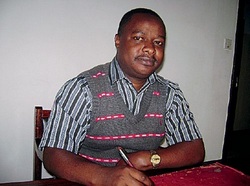
Socioeconomist Frank Mbando, Tanzania. |
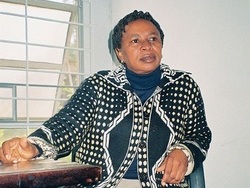
Senior agronomist Tuaeli Mmbaga, Tanzania.
The way forward will include training farmers to provide them with further education on how to manage their land.”
–Tuaeli Mmbaga
|
Better varieties
While the main research thrust is on conservation agriculture, CIMMY T and ICRISAT are participating in accelerated breeding and performance trials that aim to introduce farmers to maize and legume varieties that yield well in good years and are resilient enough in the bad seasons to help reduce farmers’ risks.
Mr. Mbando is tracking impacts associated with the new varieties and says the farmers’ response to the studies has been positive.
“They suggested that breeders take into account farmers’ criteria when making selections, so a participatory approach will be used to evaluate varieties,” he says. “So far, farmers have indicated early maturity, pest and disease tolerance, high yields and marketability as the preferred traits. Variety registration and production will then also be stepped up to make the seed available in sufficient quantities.”
Partnership approach
Mbulu district, located about 50 kilometres from Karatu, is the next community targeted for SIMLESA activities in Tanzania, to start after the current crop has been harvested. At the SIMLESA inception meeting, farmers agreed to leave post-harvest residue on the ground in preparation for the trials. Field activities in the Eastern Zone districts of Gairo and Mvomero are expected to begin in the next growing season.
Ms. Tuaeli Mmbaga, the senior agronomist on this project, says that with support from extension officers, farmers will assess the technology both pre-harvest and post-harvest.
“The way forward will include training farmers to provide them with further education on how to manage their land,” she says. “This will include an Innovation Learning Platform in partnership with farm produce stockists, community leaders, and other stakeholders to ensure that more people become involved with the project.”
Crop modeling scientist Dr. Daniel Rodriguez, who leads the Queensland component of ACIAR’s SIMLESA program, is convinced that research to reduce food shortages in eastern and southern Africa could have many benefits for farmers, including in his native Queensland.
“Our scientists will be working to improve the resilience and profitability of African farms, providing access to better seeds and fertilisers to raise the productivity of local maize–legume farming systems,” Dr. Rodriguez says. “Together we may be able to help solve one of the greatest challenges for the developed world—eliminating hunger and poverty in Africa—while at the same time boosting legume production here in Australia.”
Building agricultural research capacity
ACIAR’s Dr. John Dixon says the emphasis of Australia’s direct involvement is on building capacity within the African agricultural research system.
“Conservation agriculture amounts to a substantial shift in farming practices for the region,” Dr. Dixon says. “But it stands to provide so many advantages—not just greater water-use efficiency and soil health but also opportunities to break disease cycles and improve livestock nutrition.”
These are long-term efforts that need to be adapted to many agro-climatically diverse locations, Dr. Dixon says. “So it is vital that the African agricultural research system is built up so that it can take lead responsibility for implementing innovation into the future.”
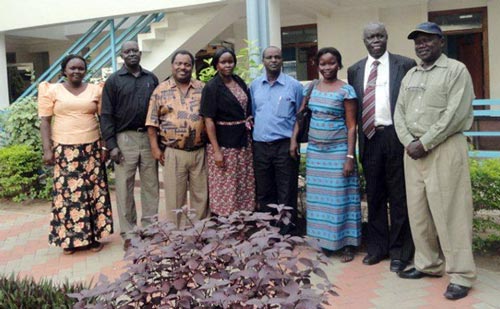 South Sudan, Africa’s newest country, is set to benefit from the project “Sustainable Intensification of Maize-Legume Cropping Systems in Eastern and Southern Africa” (SIMLESA), following fruitful discussions between project representatives and South Sudan’s Ministry of Agriculture and Forestry (MoAF). Project coordinator Mulugetta Mekuria and agronomist Fred Kanampiu met with George Leju, Director General of Research, Training, and Extension Services, Cirino Oketayot, Executive Director of Research, and Luka Atwok, maize breeder, in Juba on 6 June 2012. Mekuria gave an overview of the project’s vision, focus, and accomplishments to date and explained how SIMLESA’s experiences can reach and benefit South Sudan. The opportunity for collaboration was first discussed in Rwanda in October 2011 and since then Atwok has attended a series of SIMLESA-organized trainings and workshops.
South Sudan, Africa’s newest country, is set to benefit from the project “Sustainable Intensification of Maize-Legume Cropping Systems in Eastern and Southern Africa” (SIMLESA), following fruitful discussions between project representatives and South Sudan’s Ministry of Agriculture and Forestry (MoAF). Project coordinator Mulugetta Mekuria and agronomist Fred Kanampiu met with George Leju, Director General of Research, Training, and Extension Services, Cirino Oketayot, Executive Director of Research, and Luka Atwok, maize breeder, in Juba on 6 June 2012. Mekuria gave an overview of the project’s vision, focus, and accomplishments to date and explained how SIMLESA’s experiences can reach and benefit South Sudan. The opportunity for collaboration was first discussed in Rwanda in October 2011 and since then Atwok has attended a series of SIMLESA-organized trainings and workshops.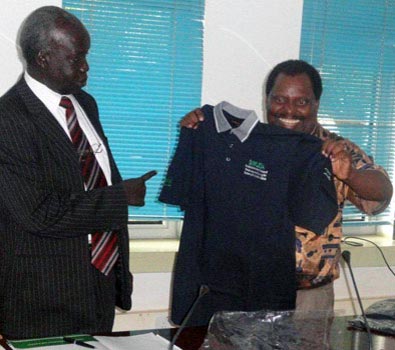 “ACIAR has availed initial funding for spillover activities,” said Mekuria. “The idea is to ensure that SIMLESA research results are quickly scaled out to countries like South Sudan and improve food security there.”
“ACIAR has availed initial funding for spillover activities,” said Mekuria. “The idea is to ensure that SIMLESA research results are quickly scaled out to countries like South Sudan and improve food security there.”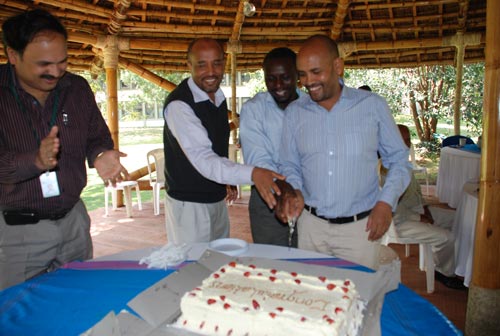 To share the good news, the Socioeconomics program hosted a get-together with the team in Nairobi, Kenya. During the cake cutting ceremony, the best gender paper award was dedicated to women farmers from Embu and Kakamega in Kenya’s Eastern and Western Provinces, where the data was collected. The Nairobi team also took the opportunity to initiate monthly seminars in order to share research findings hosted by the Global Maize Program and the Socioeconomics program and promote regular interaction among the team. The program directors, Bekele Shiferaw and B. M. Prasanna nominated Dan Makumbi, Hugo De Groote, Sika Gbegbelegbe, Fred Kanampiu, and Sarah Kibera, to form the organizing committee for the seminars.
To share the good news, the Socioeconomics program hosted a get-together with the team in Nairobi, Kenya. During the cake cutting ceremony, the best gender paper award was dedicated to women farmers from Embu and Kakamega in Kenya’s Eastern and Western Provinces, where the data was collected. The Nairobi team also took the opportunity to initiate monthly seminars in order to share research findings hosted by the Global Maize Program and the Socioeconomics program and promote regular interaction among the team. The program directors, Bekele Shiferaw and B. M. Prasanna nominated Dan Makumbi, Hugo De Groote, Sika Gbegbelegbe, Fred Kanampiu, and Sarah Kibera, to form the organizing committee for the seminars.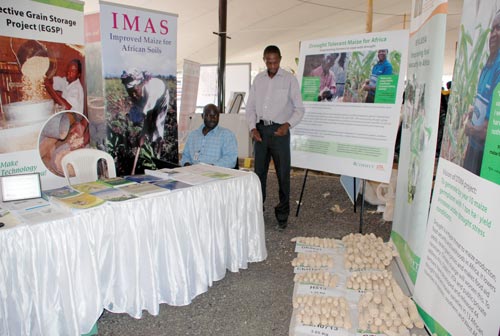 As part of European Union Day celebrations in Kenya, an exhibition to showcase research and development activities supported by the EU or its member states took place on 09 May 2012 at the International Centre of Insect Physiology and Ecology (ICIPE) in Nairobi. CIMMYT was among 12 exhibitors participating and featured the projects Drought Tolerant Maize for Africa (DTMA), Insect Resistant Maize for Africa (IRMA), Effective Grain Storage (EGS), Improved Maize for African Soils (IMAS), and Sustainable Intensification of Maize-Legume Cropping System for Food Security in Eastern and Southern Africa (SIMLESA). On display were cobs of CIMMYT and commercial maize hybrids harvested from drought stressed plots alongside cobs of the same hybrids from fully irrigated plots. Several CIMMYT publications were available for visitors.
As part of European Union Day celebrations in Kenya, an exhibition to showcase research and development activities supported by the EU or its member states took place on 09 May 2012 at the International Centre of Insect Physiology and Ecology (ICIPE) in Nairobi. CIMMYT was among 12 exhibitors participating and featured the projects Drought Tolerant Maize for Africa (DTMA), Insect Resistant Maize for Africa (IRMA), Effective Grain Storage (EGS), Improved Maize for African Soils (IMAS), and Sustainable Intensification of Maize-Legume Cropping System for Food Security in Eastern and Southern Africa (SIMLESA). On display were cobs of CIMMYT and commercial maize hybrids harvested from drought stressed plots alongside cobs of the same hybrids from fully irrigated plots. Several CIMMYT publications were available for visitors. ACIAR’s Dr. John Dixon and Dr. Daniel Rodriguez of the Queensland Alliance for Agriculture and Food Innovation, with farmers from Melkassa, Ethiopia
ACIAR’s Dr. John Dixon and Dr. Daniel Rodriguez of the Queensland Alliance for Agriculture and Food Innovation, with farmers from Melkassa, Ethiopia



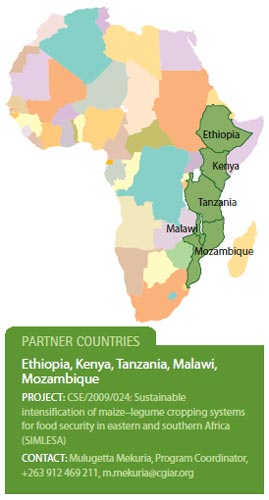


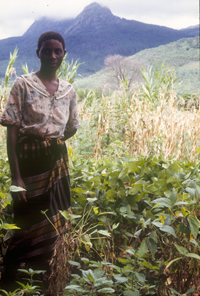 CIMMYT has entered into a collaborative research program to increase household and regional food security and incomes, as well as economic development, in eastern and southern Africa, through improved productivity from more resilient and sustainable maize-legume farming systems. Known as “Sustainable intensification of maize-legume cropping systems for food security in eastern and southern Africa” (SIMLESA), the program aims to increase productivity by 30% and reduce downside risk by 30% within a decade for at least 0.5 million farm households in those countries, with spill-over benefits throughout the region. In addition to CIMMYT, the program involves the
CIMMYT has entered into a collaborative research program to increase household and regional food security and incomes, as well as economic development, in eastern and southern Africa, through improved productivity from more resilient and sustainable maize-legume farming systems. Known as “Sustainable intensification of maize-legume cropping systems for food security in eastern and southern Africa” (SIMLESA), the program aims to increase productivity by 30% and reduce downside risk by 30% within a decade for at least 0.5 million farm households in those countries, with spill-over benefits throughout the region. In addition to CIMMYT, the program involves the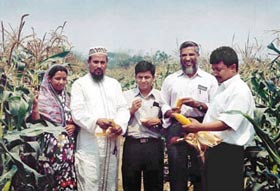 Demand for maize has popped up across Asia, but much of the grain is enjoyed by poultry, not people. In Bangladesh, maize is a fairly new crop, yet demand in this country already mirrors that of neighboring nations like China and India. A recent CIMMYT report explores these emerging trends and the efforts to incorporate sustainable and economically viable maize cropping systems into a traditionally rice-based country.
Demand for maize has popped up across Asia, but much of the grain is enjoyed by poultry, not people. In Bangladesh, maize is a fairly new crop, yet demand in this country already mirrors that of neighboring nations like China and India. A recent CIMMYT report explores these emerging trends and the efforts to incorporate sustainable and economically viable maize cropping systems into a traditionally rice-based country.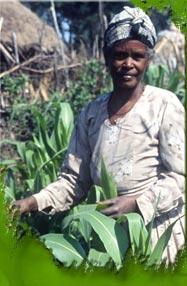 On 22 June 2004, CIMMYT culminated a year of hard work and planning to bring a new focus and intensity to the Center’s efforts in sub-Saharan Africa (SSA) by launching its new African Livelihoods Program (ALP) in Nairobi, Kenya. An extensive strategic planning exercise involving stakeholders, donors, and Center staff in the year before the launch resulted in a restructuring of the Center and its programs along with the creation of the ALP.
On 22 June 2004, CIMMYT culminated a year of hard work and planning to bring a new focus and intensity to the Center’s efforts in sub-Saharan Africa (SSA) by launching its new African Livelihoods Program (ALP) in Nairobi, Kenya. An extensive strategic planning exercise involving stakeholders, donors, and Center staff in the year before the launch resulted in a restructuring of the Center and its programs along with the creation of the ALP.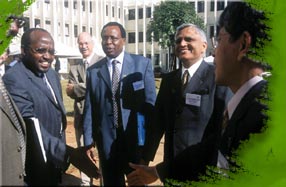 This new course relies on an integrated approach based on teams from diverse fields that bring their expertise to bear on specific problems. Projects will go beyond just the development of variety and technology to explore how to reach farmers with these improvements. CIMMYT cannot do this alone, and there will be a new focus on effective partnerships and networks to “deliver the goods” to farmers.
This new course relies on an integrated approach based on teams from diverse fields that bring their expertise to bear on specific problems. Projects will go beyond just the development of variety and technology to explore how to reach farmers with these improvements. CIMMYT cannot do this alone, and there will be a new focus on effective partnerships and networks to “deliver the goods” to farmers.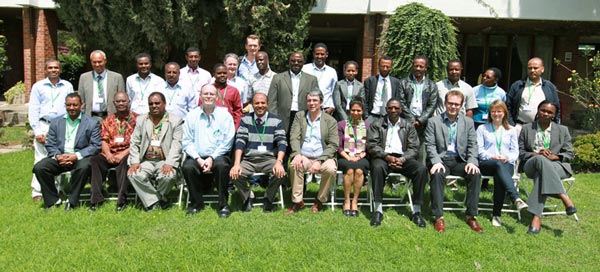
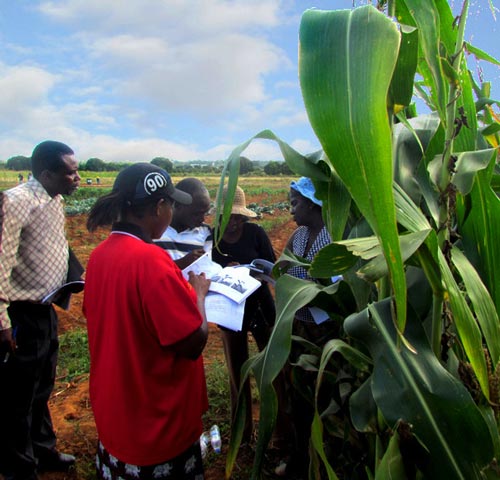 During the week of 15-20 April 2012, 36 maize technicians participated in a training session in Lusaka, Zambia. The participants were selected from seven seed companies in Zambia, national agricultural research organizations, and NGOs involved in agricultural research and extension in the eastern province of Zambia. The objective of the course was to update maize technical staff on implementing on-station and on-farm trials, seed production, and the use of secondary traits in selecting superior genotypes under low nitrogen, heat and drought trials, and it combined both lectures and field work.
During the week of 15-20 April 2012, 36 maize technicians participated in a training session in Lusaka, Zambia. The participants were selected from seven seed companies in Zambia, national agricultural research organizations, and NGOs involved in agricultural research and extension in the eastern province of Zambia. The objective of the course was to update maize technical staff on implementing on-station and on-farm trials, seed production, and the use of secondary traits in selecting superior genotypes under low nitrogen, heat and drought trials, and it combined both lectures and field work.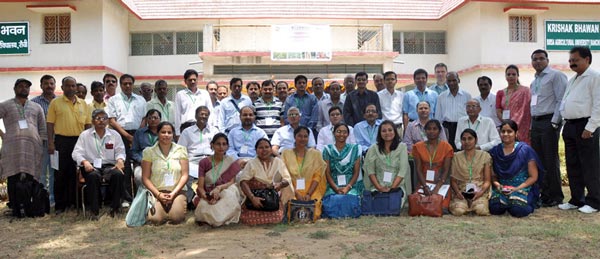
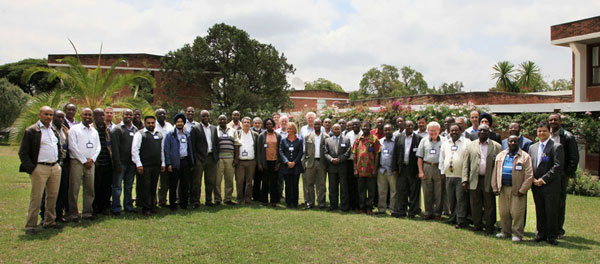
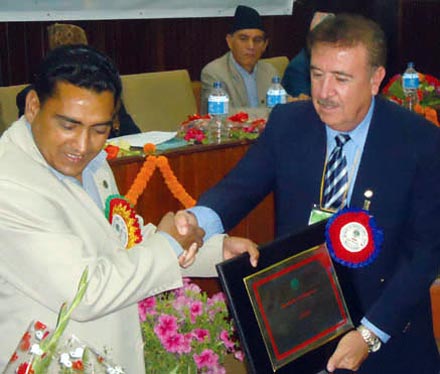 Receiving the prize on behalf of CIMMYT, Nepal country representative Guillermo Ortiz-Ferrara thanked the Society for the recognition. “On behalf of the director general of CIMMYT, Dr. Thomas Lumpkin, the center’s management, and colleagues who have been based in Nepal and the region for more than 26 years, we thank SAS-N for this great honor,” he said. “I would like to give special thanks to the government of Nepal and the MoAC for hosting CIMMYT’s regional office. Finally, we thank the many government and non-government organizations for their long-standing partnership and collaboration.”
Receiving the prize on behalf of CIMMYT, Nepal country representative Guillermo Ortiz-Ferrara thanked the Society for the recognition. “On behalf of the director general of CIMMYT, Dr. Thomas Lumpkin, the center’s management, and colleagues who have been based in Nepal and the region for more than 26 years, we thank SAS-N for this great honor,” he said. “I would like to give special thanks to the government of Nepal and the MoAC for hosting CIMMYT’s regional office. Finally, we thank the many government and non-government organizations for their long-standing partnership and collaboration.”
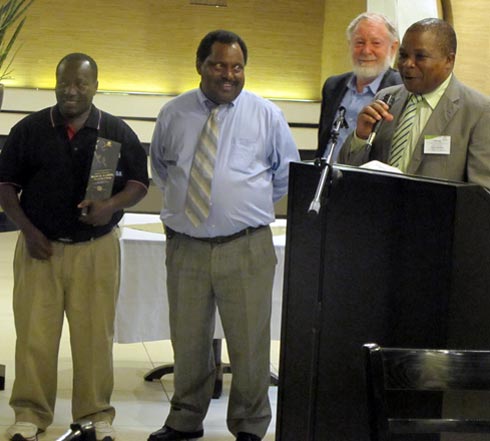 Speaking at the SIMLESA’s second “birthday party,” Joana Hewitt, chairperson of the ACIAR Commission for International Agricultural Research, reiterated the Australian government’s commitment to long-term partnerships with African governments. Participants also heard of the new SIMLESA Program in Zimbabwe, focusing on crop-livestock interactions. During the dinner, Kenya and Mozambique were recognized for their efforts in promoting and strengthening local innovation platforms.
Speaking at the SIMLESA’s second “birthday party,” Joana Hewitt, chairperson of the ACIAR Commission for International Agricultural Research, reiterated the Australian government’s commitment to long-term partnerships with African governments. Participants also heard of the new SIMLESA Program in Zimbabwe, focusing on crop-livestock interactions. During the dinner, Kenya and Mozambique were recognized for their efforts in promoting and strengthening local innovation platforms.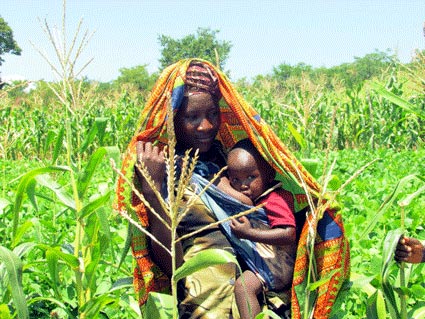 In February 2012 several CIMMYT staff working in
In February 2012 several CIMMYT staff working in